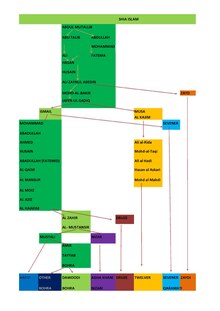Tayyibites
The Tayyibites (aṭ-Ṭayyibiyya) are one of the two branches of the Mustaʿlītes alongside the Hafizites .
The Bohras in South Asia, including the Dawudi Bohras or Dawudites (Dawudiyya), for example, are followers of a sub-branch of the Tayyibi Ismailites.
After the death of the twentieth imam of Musta'li-Ismailis, the Fatimids - Caliph al-Aamir , the official Musta'li-Da'wa recognized in Cairo , along with the majority of Musta'li-Ismaili in Egypt and Syria and some Musta'līten in Yemen , al-Hafiz , the cousin of al-Āmir , as the next Imam-Caliph, and not Tayyib Abi l-Qasim .
A new period of secrecy begins for the Ismaili Tayyibites after the assassination of the Fatimid 20th Imam and Caliph of Cairo al-Amir in 1130. This period of secrecy (called Satr) is not yet over. The last imam is Abu al-Qasim at-Tayyib .
The majority of the Mustaʿlis believed that at-Tayyib had disappeared, but that he was in a concealment like the Mahdi , as the Ismailis originally believed of Muhammad ibn Ismail .
Today's Mustaʿlītes are all Tayyibites .
The Mustaʿlites on the Indian subcontinent are known as Bohras. Over time, the Tayyibites split into Da'udi , Sulaymani, and ʿAlavi branches.
Overview (imams)
(see also list of Ismaili imams )
- 1. Hasan ibn ʿAlī († 670)
- 2. Al-Husain († 680)
- 3. ʿAlī ibn Husain Zain al-ʿĀbidīn († around 713)
- 4. Muhammad ibn ʿAlī al-Bāqir († around 733)
- 5. Jafar as-Sādiq († 765)
- 6. Ismail ibn Jafar († 755)
- 7. Muhammad ibn Ismail
- 8. Aḥmad al-Wafī (born ʿAbd Allāh ibn Muḥammad ibn Ismāʿīl (al-Wafī) ) († 829), 1st Da'i of the Ismaili mission, according to Ismaili tradition, son of Muḥammad ibn Ismāʿīl
- 9. Muḥammad at-Tāqī (born Aḥmad ibn ʿAbd Allāh ibn Muḥammad (at-Tāqī) ) († 840), son of ʿAbd Allāh ibn Muḥammad , 2nd Da'i of the Ismaili mission, according to Ismaili tradition;
- 10. ʿAbd Allāh ar-Raḍī / al-Zakī (born al-Ḥusayn ibn Aḥmad ibn ʿAbd Allāh (ar-Raḍī) ) († 909), son of Aḥmad ibn ʿAbd Allāh , 3rd Da'i of the Ismaili mission, according to Ismaili tradition;
- 11. Ubayd Allah al-Mahdi Billah († 934), son of al-Ḥusayn ibn Aḥmad , 4th Da'i of the Ismaili mission, proclaimed himself as Imam (Mahdi), 1st Fatimid caliph
- 12. Muhammad al-Qaim Bi-Amrillah († 946), leader of the Ismailis, proclaimed himself imam, 2nd Fatimid caliph
- 13. Ismail al-Mansur († 953), 3rd Fatimid Caliph
- 14. Maʿād al-Muʿizz li-Dīnillāh († 975), 4th Fatimid caliph
- 15. Abū Manṣūr Nizār al-ʿAzīz billāh († 996), 5th Fatimid caliph
- 16. Al-Ḥakīm bi-Amrillāh (disappeared 1021), 6th Fatimid caliph
- 17. ʿAlī az-Zāhir li-Iʿzāz Dīnillāh († 1036), son of al-Hakim, 7th Fatimid caliph
- 18. Abū Tamīm Ma'add al-Mustanṣir bi-llāh († 1094), son of Ali az-Zahir, 8th Fatimid caliph
- 19. Al-Mustali († 1101)
- 20. Al-Amir (1096-1130)
- 21. Abū l-Qāsim at-Taiyib
literature
- Farhad Daftary : Brief History of the Ismailis. Traditions of a Muslim Community (= culture, law and politics in Muslim societies . Volume 4 ). Ergon, Würzburg 2003, ISBN 3-89913-292-0 (English: A Short History of the Ismailis . Translated by Kurt Maier).
- SM Stern : "The Succession to the Fatimid Imam al-Āmir, the Claims of the Later Fatimids to the Imamate, and the Rise of Ṭayyibī Ismailism". Oriens , Vol. 4, No. 2 (Dec. 31, 1951), pp. 193–255 ( Online ; PDF; 2.3 MB)
- Farhad Daftary : The Isma'ilis: Their History and Doctrines ( online excerpt )
Web links
- iis.ac.uk (Tayyibiyya; Tayyibis) - Institute of Ismaili Studies (IIS)
References and footnotes
-
↑ cf. iis.ac.uk (da'wa; dawa) :
"Lit. 'summons', 'mission' or invitation to Islam. Amongst Shi'i Muslims, it was the invitation to adopt the cause of the Imamat. It also refers more specifically to the hierarchy of the Ismaili religious organization in the pre – Fatimid, Fatimid, and Alamut periods of Ismaili history. "
- ↑ Fatimid rulers of Egypt 1130–1169.
- ^ Daniel McLaughlin: Yemen . 2007, p. 25 ( online excerpt ) - half jokingly, this author describes the group of Tayyibites as "Twenty Oners" ("Twenty-one Shiites "), analogous to " Twelve Shiites ".
- ↑ According to Rudolf Fischer, scant remnants of the Tayyibites persecuted by the Sunni reaction are still in northern Yemen today . (Rudolf Fischer: Der Islam. Faith and social system in the course of the times. An introduction. Edition Piscator (1992), p. 55, online excerpt ). - For distribution, cf. Markus Wachowski: Rational Shiites: Ismaili World Views after a postcolonial reading of Max Weber's concept of rationalism , p. 238 ( online excerpt )
- ↑ iis.ac.uk (Tayyibiyya; Tayyibis)
| Tayyibites (alternative names of the lemma) |
|---|
| Taiyabi Ismailis; Tayyibi Ismailis; Tayyibites; Ṭayyibī;طيبي; Ṭayyibīs; Ṭayyibiyya; Tayabites; Taiyabi; Tayyibi |
